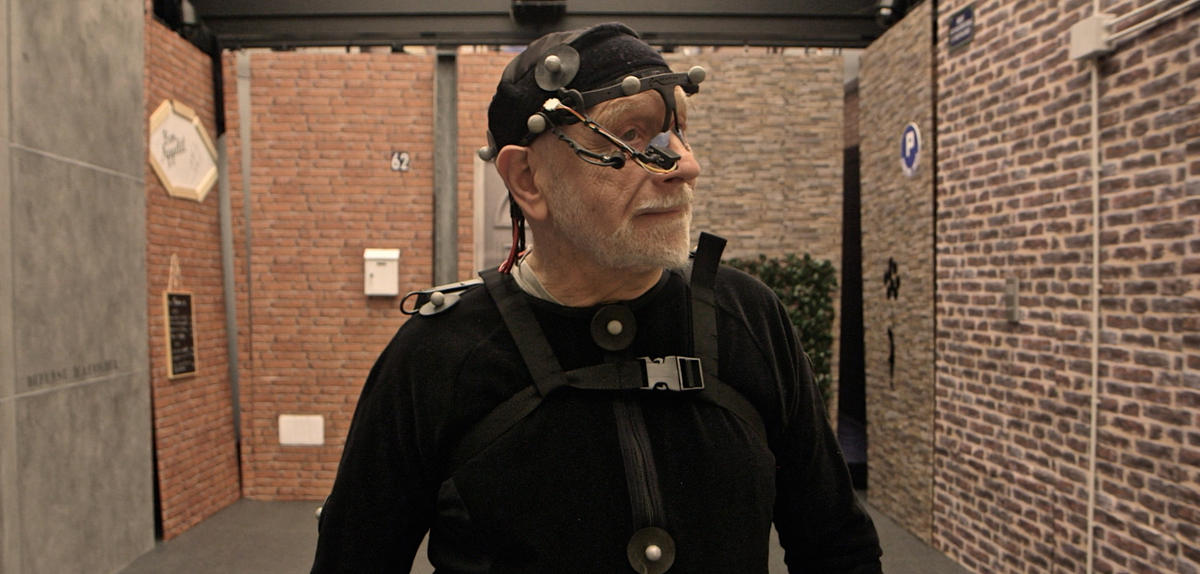You are here
Transcript
Close
Behind the scenes. It may seem that these stagehands are preparing the set of a new Broadway musical. But there will be no theatrics on this set, only Science. Welcome to the Street Lab, a modular platform that offers a realistic immersion in an artificial urban setting. These scientists are studying the effects of old age on our sense of sight. As we grow older, do we interact with our environment differently? Does our perception of the world change? To test this, research subjects come to the Street Lab with specific instructions to follow. The environment is fully controlled: the lighting, sound and panels here can all be adjusted for the experiment.
00:41
ITV Angelo ARLEO, neuroscientist
The idea of this artificial street is to create a world that looks as realistic as possible. The main advantage of having a modular set is that we are going to test the subject in a certain configuration with specific visual clues. We are then going to shift the environment to create a conflict between what the subject had previously learned and the same set of instructions to follow once the environment has changed. We’re going to test how the subject copes with this discrepancy that arises between what is expected and what has changed.
Here at the Vision Institute in Paris, the team of scientists led by Angelo Arleo selected research subjects of different ages to compare results.
Once in the Street Lab, they will need to go from point A to point B using various visual clues.
To collect the most data as possible, the subject is equipped with reflective markers and an infra-red camera able to film the rapid movements of his eye; these can be associated with specific cognitive activity and track exactly what he is looking at as he explores his environment.
01:59
ITV ANGELO 27s
What’s interesting for us is to follow the progress of each part of the body: the head, the body and the eyes, as the subject explores the setting and navigates towards his goal. This gives us clear indications on how the subject becomes aware of his surroundings, how he identifies his destination, and how he plans his trajectory.
In order to study the subject’s sense of direction, the researchers must first make him disoriented. Eyes closed, he is moved around listening to recorded urban sounds played through the Street lab’s speakers.
At the control center, the researchers determine the subject’s initial position and record his return path to point A. The sensors help the scientists pinpoint the visual cues used by the subject to find his way back.
Researchers use the Street Lab’s 10 infrared cameras and the same motion capture technology as in movies or video games to record a 3D version of the subject’s behavior. This computer model of the movement is then coupled with the data collected by the eye-tracking device; now we know exactly where the subject is focusing his gaze during the experiment.
Another type of disorientation is applied in the experiment’s second phase. The entire set is shifted 90 degrees. The research subject is unaware of these changes. The scientists replace the different panels – adding extra panels to lengthen the shorter sides and removing panels from the longer sides. The subject must then follow the same instructions as before: make his way back to point A. For this senior, this test highlights the difference between generations. (NB: j’ai rajouté cette phrase, mais pas necessaire)
03:48
ITV OLIVIER 19s
We still have most of our reflexes. We still know how to sense our environment. We find details, we organize the space around us. I do think a younger subject will be quicker to notice that the whole street has shifted though…
This experiment in the Street Lab is just one part of a larger research program focused on how ageing affects sight. Before taking a walk next to fake restaurants and cash machines, all subjects go through tests that classify their type of vision. By 2050, it is estimated that the number of people over 65 will have tripled worldwide. Older people greatly rely on their vision to remain autonomous and independent.
The research led here at the Vision institute will expand what we know about the way our sense of sight grows older and will help its partner, the Essilor group, develop the next generations of corrective lenses.
04:45
ITV ANGELO 28s
This is a taste of what we will one day be able to accomplish: bring the whole experiment out of the laboratory and into real life. Once we can do that, we will be able to confirm or invalidate the conclusions obtained in our largely artificial lab environment. We will then be able to test a wider variety of spaces, dimensions and environments.
Before taking the experiment out into the open, hundreds of subjects will pass the tests of Angelo Arleo and his team. What will come out of these 2 years of research is hard to predict as there is often more to science than meets the eye...
00:41
ITV Angelo ARLEO, neuroscientist
The idea of this artificial street is to create a world that looks as realistic as possible. The main advantage of having a modular set is that we are going to test the subject in a certain configuration with specific visual clues. We are then going to shift the environment to create a conflict between what the subject had previously learned and the same set of instructions to follow once the environment has changed. We’re going to test how the subject copes with this discrepancy that arises between what is expected and what has changed.
Here at the Vision Institute in Paris, the team of scientists led by Angelo Arleo selected research subjects of different ages to compare results.
Once in the Street Lab, they will need to go from point A to point B using various visual clues.
To collect the most data as possible, the subject is equipped with reflective markers and an infra-red camera able to film the rapid movements of his eye; these can be associated with specific cognitive activity and track exactly what he is looking at as he explores his environment.
01:59
ITV ANGELO 27s
What’s interesting for us is to follow the progress of each part of the body: the head, the body and the eyes, as the subject explores the setting and navigates towards his goal. This gives us clear indications on how the subject becomes aware of his surroundings, how he identifies his destination, and how he plans his trajectory.
In order to study the subject’s sense of direction, the researchers must first make him disoriented. Eyes closed, he is moved around listening to recorded urban sounds played through the Street lab’s speakers.
At the control center, the researchers determine the subject’s initial position and record his return path to point A. The sensors help the scientists pinpoint the visual cues used by the subject to find his way back.
Researchers use the Street Lab’s 10 infrared cameras and the same motion capture technology as in movies or video games to record a 3D version of the subject’s behavior. This computer model of the movement is then coupled with the data collected by the eye-tracking device; now we know exactly where the subject is focusing his gaze during the experiment.
Another type of disorientation is applied in the experiment’s second phase. The entire set is shifted 90 degrees. The research subject is unaware of these changes. The scientists replace the different panels – adding extra panels to lengthen the shorter sides and removing panels from the longer sides. The subject must then follow the same instructions as before: make his way back to point A. For this senior, this test highlights the difference between generations. (NB: j’ai rajouté cette phrase, mais pas necessaire)
03:48
ITV OLIVIER 19s
We still have most of our reflexes. We still know how to sense our environment. We find details, we organize the space around us. I do think a younger subject will be quicker to notice that the whole street has shifted though…
This experiment in the Street Lab is just one part of a larger research program focused on how ageing affects sight. Before taking a walk next to fake restaurants and cash machines, all subjects go through tests that classify their type of vision. By 2050, it is estimated that the number of people over 65 will have tripled worldwide. Older people greatly rely on their vision to remain autonomous and independent.
The research led here at the Vision institute will expand what we know about the way our sense of sight grows older and will help its partner, the Essilor group, develop the next generations of corrective lenses.
04:45
ITV ANGELO 28s
This is a taste of what we will one day be able to accomplish: bring the whole experiment out of the laboratory and into real life. Once we can do that, we will be able to confirm or invalidate the conclusions obtained in our largely artificial lab environment. We will then be able to test a wider variety of spaces, dimensions and environments.
Before taking the experiment out into the open, hundreds of subjects will pass the tests of Angelo Arleo and his team. What will come out of these 2 years of research is hard to predict as there is often more to science than meets the eye...
The Effects of Ageing on Visual Perception
04.05.2016
Does our sense of direction change as we get older? A team of researchers is studying the toll that age takes on our vision. To do this, they immerse research subjects fully equipped with sensors in an artificial street. This StreetLab, developed by the Vision Institute and the Pierre and Marie Curie University, is as modular as a movie set.
About this video
Original title:
Our Ageing Vision
Production year:
2016
Length:
5 min 51
Director:
Pierre de Parscau
Producer:
CNRS Images
Speaker(s) :
Angelo ARLEO, Vision Institute
Chairholder of the Silversight Research Chair
(UPMC – Inserm – CNRS – Essilor)
Chairholder of the Silversight Research Chair
(UPMC – Inserm – CNRS – Essilor)
Recent videos
Video





